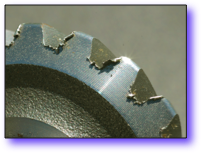Browse Categories

Browse Archives
Manufacturing Benefits Gained From Detecting and Eliminating Burrs

At the Cleveland Deburring Machine Company (CDMC), we know how precise every aspect of the mass-production process must be in order to turn out quality products in desired numbers. One little hitch in the system can cause a catastrophe on the line and kill production values for the day. And when numbers have to be continually improving to stay ahead of the competition in the market, every workpiece and every finished product counts toward success. That’s why CDMC is designing and developing deburring machines to help businesses across all markets and industries reduce their instances of potentially-damaging burrs in the manufacturing processes.
Burrs in manufacturing have been a nuisance since the start of mass production in America (sometime around the 1860s). Burrs are essentially a ridge or area of roughness that is produced during the cutting or shaping of metal parts and, in some cases, plastic parts. And although burrs are often responsible for end-product quality issues – often due to rough edges that don’t form a perfect joint when fitted together, or plating build-up on edges, or edge fractures in certain kinds of materials – the true cost to the manufacturing facility of unnecessary burrs in production are human costs.
When burrs are left unchecked and allowed to form during the manufacturing process, several things are bound to happen. Moving pieces with ragged, unsafe edges may catch on workers hands and arms. Injuries to workers, especially serious cuts to hands and arms, can cause a temporary loss of valuable labor. At the same time, it can result in an increase in worker’s comp costs, as well as a potential increase in insurance policy rates. In addition, unaddressed burrs and the manufacturing results of burrs can negatively impact production numbers due to jammed mechanisms, electrical machine short circuiting (or burn-out), and cut wires from moving metalwork. So, when it comes to putting processes and procedures in place to limit the amount of production downtime, it may benefit manufacturers to find a deburring system that’s developed to support high production and consistent product output. Hopefully, this will help keep manufacturing companies running at peak performance.
